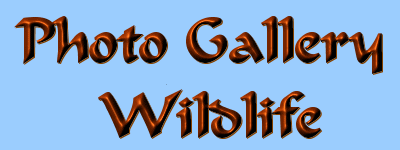
This page is a brief collection of photographs of some of the
different animals native to this great country of Australia.
I will, each couple of weeks, change these photographs.
Please enjoy!

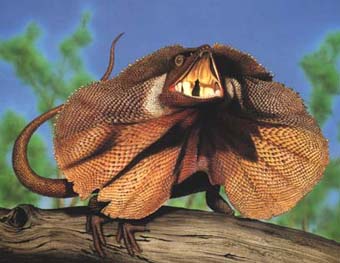 Frilled (Frillneck) Lizard
Frilled (Frillneck) Lizard
~ The frilled lizard, which was depicted on the Australian two cent coin, grows to a length of about 0.75 m (2.5 ft) and is widely distributed across northern Australia. It has a large frill skin which normally lies in loose folds around the neck but is raised like a ruff when the lizard is alarmed. Like many dragons, it is a swift-moving diurnal lizard, which often runs only on its hindlimbs when escaping at full speed.
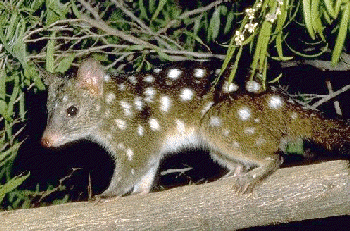 Western Quoll ~ Similar in size to the Eastern Quoll, this species is well adapted to high temperatures and aridity. These features permitted it to occupy the greater part of inland Australia but, since European settlement, its range has diminished to the relatively well-watered southwestern corner of the mainland. Its decline may have been due to an alteration of the way of life of Aborigines, who were prevented from regular burning of the understorey of open forests and savannah which led to a flush of regenerating vegetation (and insects, etc) which provided an optimal habitat.
It is an opportunistic predator on small vertebrates and large insects, taken on the ground or in trees. The Western Quoll differs from the Eastern Quoll in possessing a (small) first toe on the hindfoot.
Sexual maturity is reached at about one year. Up to six young are suckled on six teats for about fifteen weeks.
Western Quoll ~ Similar in size to the Eastern Quoll, this species is well adapted to high temperatures and aridity. These features permitted it to occupy the greater part of inland Australia but, since European settlement, its range has diminished to the relatively well-watered southwestern corner of the mainland. Its decline may have been due to an alteration of the way of life of Aborigines, who were prevented from regular burning of the understorey of open forests and savannah which led to a flush of regenerating vegetation (and insects, etc) which provided an optimal habitat.
It is an opportunistic predator on small vertebrates and large insects, taken on the ground or in trees. The Western Quoll differs from the Eastern Quoll in possessing a (small) first toe on the hindfoot.
Sexual maturity is reached at about one year. Up to six young are suckled on six teats for about fifteen weeks.
 Zebra Finch
Zebra Finch
~ The abundant Zebra Finch occurs almost throughout mainland Australia, occupying a vast range of habitats from barren deserts to coastal croplands; wherever there is some grass and a few trees or bushes for nesting and roosting. Nearby fresh water is essential. Their diet consists of seeds and insects, gathered mainly on the ground.
 Gang_Gang Cockatoo
Gang_Gang Cockatoo
~ This cockatoo is restricted to south-eastern mainland Australia from the Portland district of Victoria (rarely west into South Australia) to the Blue Mountains of New South Wales (sporadically north to Barrington Tops); it has been introduced to Kangaroo Island where it is now seldom reported, and it is vagrant in Tasmania. It has declined since European settlement and is now most common in the southern highlands.
Adult males are distinctive, with scarlet head and dusky grey body plumage narrowly scalloped in dull white. Females and immatures are dull grey but both sexes have a unique "feather-duster" crest.
It is mainly rather sedentary, but undertakes regular movement from higher altitudes in winter, at which time it is common in some highland cities, such as Canberra. Seldom encountered alone, it is usually in pairs or family parties, larger flocks often forming in winter. It is strongly arboreal but occasionally forages on the ground. Once located, a food source is usually exploited until exhausted, the birds spending much of the day feeding methodically and unobtrusively in the foliage. The tameness of feeding Gang-gang Cockatoos is well known: They can sometimes be touched by hand. They eat eucalypt seeds, fruit, and insects, and are especially fond of the berries on introduced hawthorn.
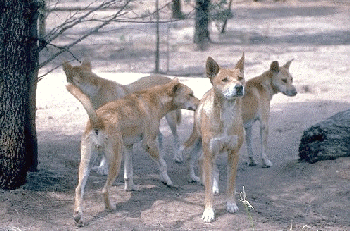 Dingo
Dingo
~ The Dingo belongs to the same species as the domestic dog and interbreeds freely with it. Nevertheless, it differs sufficiently to be regarded as a subspecies, Canis familiaris dingo. It does not bark and it breeds only once a year. The closest relatives of the Dingo are the wild or semi-domesticated dogs of south-east Asia, Indonesia and New Guinea. It is often said that Aborigines brought the Dingo to Australia but, since it appears to have been on the continent about 3,500 years ago, this seems very unlikely. It must have been introduced, perhaps accidentally, by maritime people. It is an opportunistic predator on mammals ranging in size from rodents to kangaroos: sheep and calves are also taken. When small prey are plentiful, Dingos are solitary hunters but when these are scarce and larger prey must be tackled, cooperative packs may form. Although its overall range includes the whole of the continent (but not Tasmania) it is not well adapted to arid conditions and usually needs to drink once a day. Sexual maturity is reached at about one year. Mating occurs from about March to June and a litter of 3-4 young is born from about August to November.
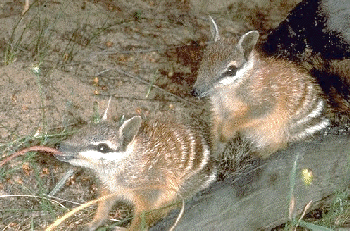
Numbat
~ The Numbat is the only marsupial that is specialised for feeding on small colonial insects. Like the Short-beaked Echidna, it picks these up with its long, rapidly-moving, sticky tongue.
Unlike the Echidna, it does not have strongly developed digging forelimbs. Its limbs are rather delicate, and the claws of its feet are not very large. It feeds mainly upon termites which it finds in soft, rotting timber or in the runways just below the surface of the ground, in which some termites travel between feeding areas and the nest.
Flora
Back to Photographs
Web Page designed
by Sandy
© 1996-2007





 Frilled (Frillneck) Lizard
Frilled (Frillneck) Lizard Western Quoll ~ Similar in size to the Eastern Quoll, this species is well adapted to high temperatures and aridity. These features permitted it to occupy the greater part of inland Australia but, since European settlement, its range has diminished to the relatively well-watered southwestern corner of the mainland. Its decline may have been due to an alteration of the way of life of Aborigines, who were prevented from regular burning of the understorey of open forests and savannah which led to a flush of regenerating vegetation (and insects, etc) which provided an optimal habitat.
It is an opportunistic predator on small vertebrates and large insects, taken on the ground or in trees. The Western Quoll differs from the Eastern Quoll in possessing a (small) first toe on the hindfoot.
Sexual maturity is reached at about one year. Up to six young are suckled on six teats for about fifteen weeks.
Western Quoll ~ Similar in size to the Eastern Quoll, this species is well adapted to high temperatures and aridity. These features permitted it to occupy the greater part of inland Australia but, since European settlement, its range has diminished to the relatively well-watered southwestern corner of the mainland. Its decline may have been due to an alteration of the way of life of Aborigines, who were prevented from regular burning of the understorey of open forests and savannah which led to a flush of regenerating vegetation (and insects, etc) which provided an optimal habitat.
It is an opportunistic predator on small vertebrates and large insects, taken on the ground or in trees. The Western Quoll differs from the Eastern Quoll in possessing a (small) first toe on the hindfoot.
Sexual maturity is reached at about one year. Up to six young are suckled on six teats for about fifteen weeks.
 Zebra Finch
Zebra Finch Gang_Gang Cockatoo
Gang_Gang Cockatoo Dingo
Dingo